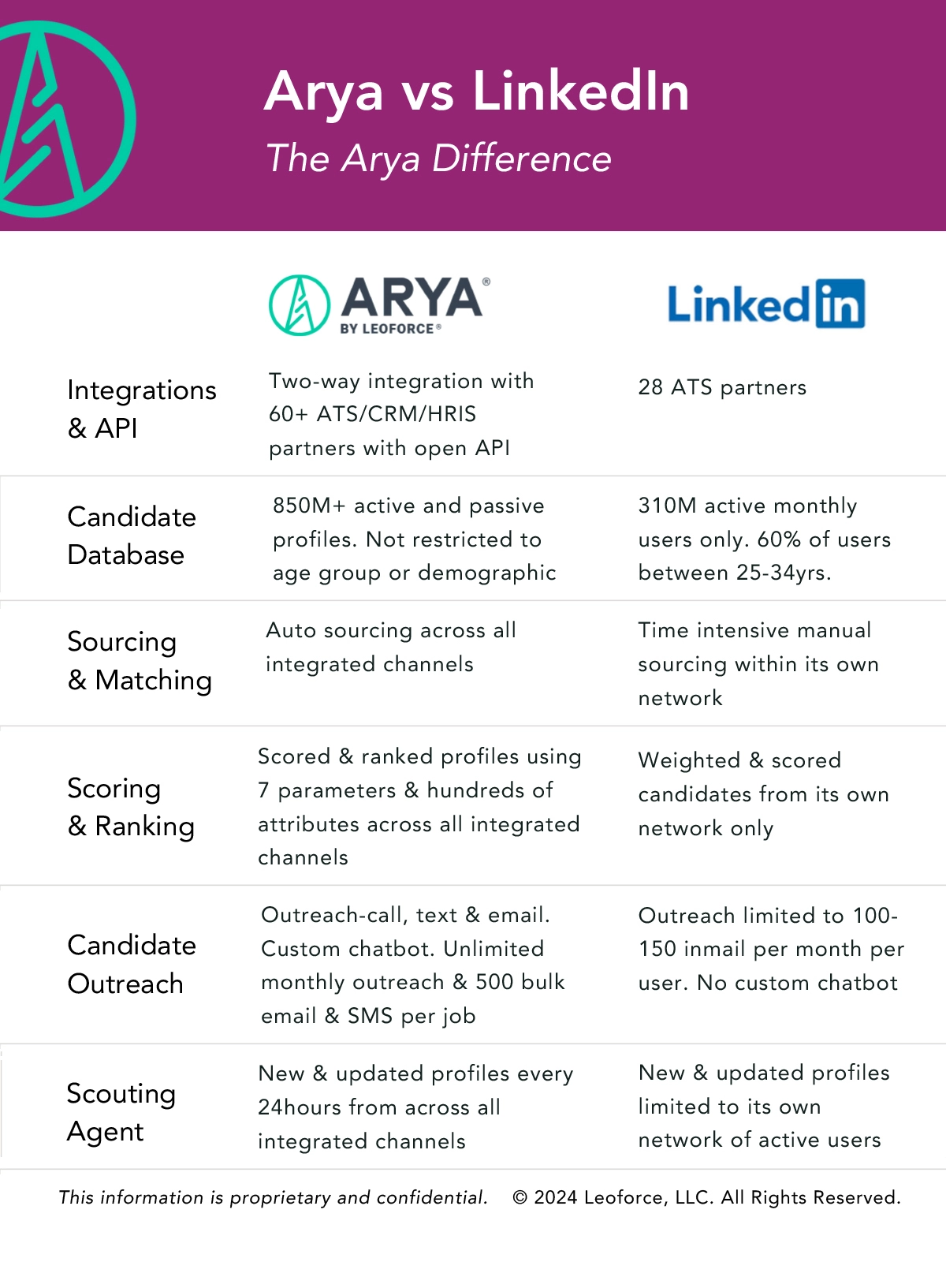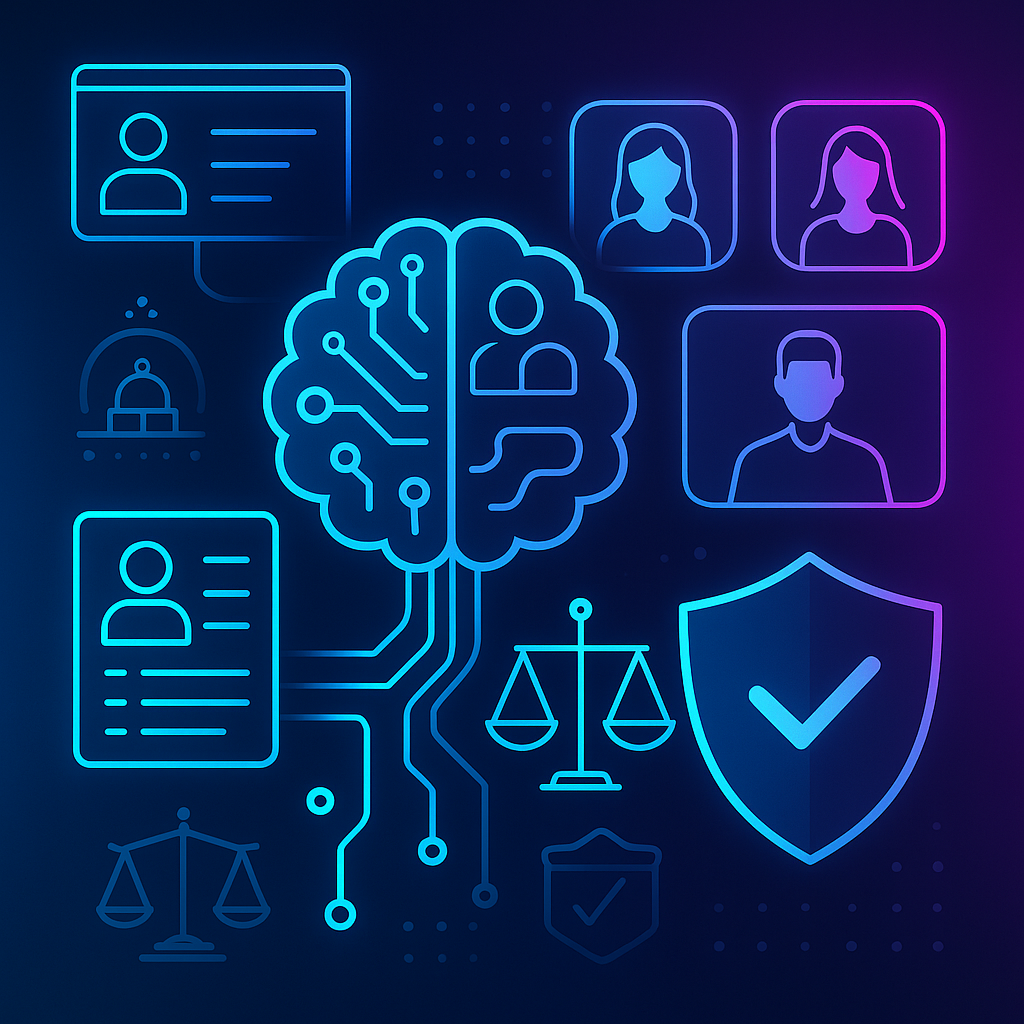AI Powered Talent Sourcing Tools vs LinkedIn

The emergence of AI-powered talent sourcing tools in recruitment marks a pivotal shift in how organizations are navigating the talent acquisition landscape. These advanced technologies are not just another addition to the recruiter’s toolkit; they are reshaping the very fabric of recruitment strategies, offering unprecedented efficiency and insight into the talent-sourcing process.
As we explore the impact of these innovative tools, it’s essential to compare their capabilities and outcomes against traditional platforms like LinkedIn, which has been a cornerstone for professional networking and recruitment across the globe.
LinkedIn, with its vast global network of members has undeniably played a crucial role in connecting recruiters with potential candidates. However, the spotlight now increasingly falls on AI sourcing tools, which are leading the charge in the recruitment revolution by automating and enhancing the talent search process.
This shift prompts a closer examination of how businesses and individuals adapt to and benefit from the unique strengths of these cutting-edge technologies and how they compare to a platform such as LinkedIn.
Why AI Sourcing Tools are the Top Choice of Industry Leaders
AI-powered sourcing platforms harness the power of artificial intelligence to automate candidate sourcing and screening processes, saving recruiters tremendous amounts of time and effort. But it’s not just about efficiency; AI sourcing tools offer deeper insights into candidates’ backgrounds and suitability for roles by analyzing vast amounts of data from multiple sources.
Automated Candidate Matching: AI sourcing tools use sophisticated algorithms to match candidates to job requirements with unparalleled accuracy. No more manual searches or guesswork—just precise matches in seconds.
Comprehensive Candidate Insights: By aggregating data from various channels, including resumes, social media, and professional networks, AI sourcing tools provide recruiters with a 360-degree view of candidates, from their skills and experiences to their cultural fit.
Predictive Analytics: Some AI sourcing tools go a step further by offering predictive analytics and talent intelligence capabilities, empowering recruiters to anticipate candidate availability, market trends, hiring success rates and much more.
Scalability and Efficiency: With AI sourcing tools, recruiters can scale their efforts effortlessly, reaching a broader talent pool without sacrificing quality or speed. It’s recruitment on autopilot—only smarter and more effective.
LinkedIn in Recruitment
Although LinkedIn has long been associated with recruitment and job searches, when it comes to arguably, the most important aspect of talent acquisition and recruitment – candidate sourcing, it’s important to look a little deeper into the capabilities, as well as the limitations of LinkedIn in terms of effective talent sourcing.
Registered Users vs Active Users: Even though the platform boasts a vast number of users worldwide, that number includes more than just active and passive candidate profiles. It also encompasses duplicate and inactive profiles. According to a Statista market research report, The number of daily active LinkedIn users is approximately 141 million and active monthly users hovers around 310 million.
If you’re asking yourself why the number of active members is relevant to recruitment, consider one of the biggest challenges recruiters face when it comes to sourcing top talent – a shortage of qualified candidates and fierce competition for the ones that are out there.
Logically, the more expansive your talent pool, the better your chances are of finding the unicorn candidates who meet the criteria you’re looking for.
Single Source of Talent: Unlike some advanced AI sourcing tools, who aggregate multichannel sources into a single interface, LinkedIn’s talent solutions only offer access to the talent within their own database.
Inaccurate Candidate Data: An even bigger issue is ensuring candidate profiles are up to date. Because LinkedIn relies on the individual user to update their own profile, there’s no guarantee the candidate you’re trying to engage with is accurately represented or that their data is correct.
Limited Access to User Base: LinkedIn’s user base is massive, but its talent solutions do not automatically grant recruitment professionals access to their entire user base. Your access is dependent on the product tier you purchase.
For example, the lowest tier only allows you to post jobs, while the middle tier includes only job posting + access to the 1st, 2nd or 3rd degree candidates in your network, and the top tier (and most costly) – jobs + recruiter offers unlimited access to all LinkedIn members.
But access to more than a database of millions of inactive users is the equivalent of having access to millions of Myspace profiles. The number of users doesn’t matter if the majority aren’t actually using the platform. There are also manual sourcing processes to consider.
Manual, Unreliable Search and Match: Scouring through countless profiles manually can be a time-consuming and tedious task. This might be the primary driver behind the demand and influx of AI sourcing and recruiting tools. The sheer effort required to effectively identify and engage the right candidates for the right jobs – faster than your rivals.
With LinkedIn, recruiters using the middle and top tier of their talent solutions can use search filters to narrow in on qualified candidates. However, for the middle tier, there are only 20+ filters available and 40+ for the top tier. It bears mentioning that only users who have purchased the top tier are able to access candidates who have toggled the “Open to Work” indicator.
It’s likely to take much more leg work and research to uncover the candidates most likely to succeed in the role using LinkedIn because the burden falls to the recruiter to read between the lines of a candidate profile to determine the right fit. Plus, relying solely on LinkedIn profiles may not always provide a holistic view of candidates’ skills and experiences. Not to mention, the cost of accessing premium features can add up.
On the other hand, with an AI sourcing tool, the matching part of the process is literally done for you. Here’s where AI sourcing tools are superior to LinkedIn in terms of accelerating the process and increasing applicant quality. That doesn’t mean LinkedIn isn’t a powerful tool for organizations to leverage in other areas of their business.
Leveraging LinkedIn
There’s no denying the power of LinkedIn when it comes to professional networking, marketing, and brand promotion. Especially when you factor in not just its global member base, but also the 67 million companies registered on LinkedIn. The platform is quite literally its own ecosystem. Companies and individuals can harness the power of LinkedIn in different ways to achieve their business and career goals.
Networking and Relationship Building: For individuals, LinkedIn isn’t just a platform for job hunting. It’s a place where professionals come together, share ideas, support each other on their journey to success, and often spark conversations that lead to new opportunities.
Individual users can leverage LinkedIn’s recommendations and endorsements feature to showcase their skills and expertise while also endorsing the abilities of their connections. These endorsements and recommendations are valuable social proof of skills and help build credibility within a given industry.
For businesses, LinkedIn serves as a strategic tool for expanding professional networks and cultivating relationships with potential clients, partners, and industry influencers. By actively engaging with relevant LinkedIn groups, participating in industry events, and connecting with key stakeholders, companies leverage LinkedIn to build rapport and establish trust in their respective fields.
Marketing and Brand Promotion: Considering the vast reach of LinkedIn, it’s easy to understand the allure of the platform as a marketing and brand building tool. LinkedIn’s advertising solutions enable businesses to target specific audiences based on criteria such as job title, industry, and professional interests.
Sponsored content, InMail, and display ads help companies increase brand visibility, drive website traffic, and generate leads directly within the LinkedIn ecosystem. One survey of B2B marketers found that 40% of respondents point to LinkedIn as the most effective channel for driving high-quality B2B leads.
While LinkedIn is great for networking and building a brand, AI tools are built to directly address the challenges of modern recruiting. They’re efficient, reduce the workload, and help recruiters connect with candidates in a data-driven way. Among the pioneers in AI sourcing and talent engagement is Leoforce by Leoforce, a platform that is changing the game for recruiters and talent acquisition leaders.
Introducing Leoforce: Redefining Recruitment
Leveraging advanced AI with 10+ years of learning and refinement, Leoforce streamlines the entire recruitment process, from candidate sourcing, and engagement, to database refresh services and delivering interview-ready, qualified applicants via Applicants On Demand.
By leveraging Leoforce’s powerful capabilities, recruiters can access top talent faster, make data-driven hiring decisions, and stay ahead of the competition. Here’s why industry leading companies choose Leoforce for their talent sourcing and engagement needs:
Recruiters Save up to 12 Hours per Job in Sourcing Time: Leoforce’s advanced auto search, match, and talent insights enable recruiters to source, score, and rank candidates in less than 5 minutes, empowering them to spend less time searching and more time building candidate relationships.
Decrease Recruiting Costs by up to 50%: Leoforce consolidates all your sourcing channels and combines them with the largest proprietary candidate database in the industry sourced from 80+ channels across 150+ industries into a single interface. No more paying per user or per channel.
Improve Candidate Quality by up to 70%: You input the job parameters and Leoforce does the heavy lifting of sourcing the ideal candidates for the role using 7 multidimensional data points and hundreds of attributes to score, rank and predict the likelihood of candidate success in the role. You get a deduplicated list in seconds of ideal candidates.
Boost Recruiter Productivity by up to 80%: Leoforce provides a detailed explanation for every candidate score, enabling recruiters to make data-driven hiring decisions and driving maximum productivity.
Optimize Candidate Engagement and Experience: Reach top talent before your rivals with access to new and updated candidate information daily, a 24/7 AI recruiting assistant, and a centralized multi-channel communication dashboard.
Leoforce vs LinkedIn: A Side-by-Side Comparison

Final Thoughts
As the world of recruiting continues to evolve, we’re seeing the limits of traditional platforms like LinkedIn, especially when it comes to finding quality candidates. That’s where AI-powered tools like Leoforce come into play, making the search for talent faster and smarter.
Unlike LinkedIn, which depends on what users post and manual searching, AI tools automate the matching process, dive into a broader talent pool, and use data from multiple sources to find the right candidates quickly and efficiently.
Let’s face it – a critical component to success in any industry is using the right tool for the job: LinkedIn for networking and brand building, and AI tools like Leoforce for more targeted, efficient candidate sourcing. Combining the strengths of both means recruiters can work smarter, cut costs, and find the perfect candidates to help their businesses thrive.
Ultimately, this blend of LinkedIn’s networking power and AI’s efficiency is what’s shaping the future of recruitment, ensuring companies can keep up with the changing demands of talent acquisition for success.
Take your recruiting strategy into the future and beyond with Leoforce. Book your 1:1 demo today and see Leoforce in action for yourself.
With Leoforce’s assistance, Workable evolves into a more agile and efficient recruitment solution, empowering HR teams to make smarter, data-driven decisions while fostering a seamless candidate experience.





